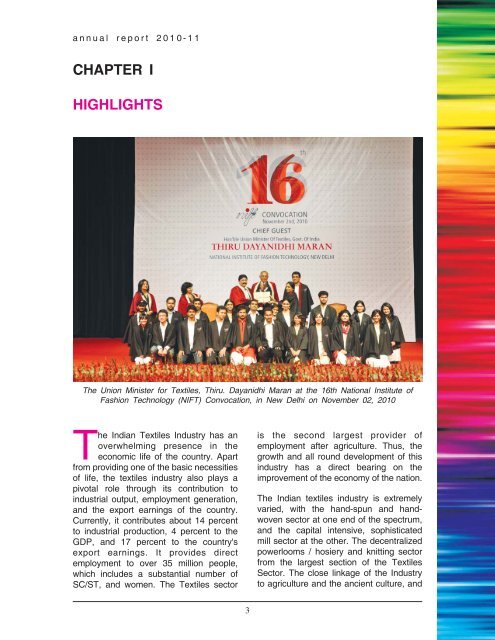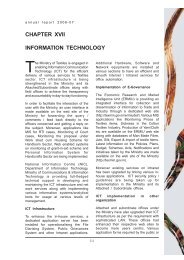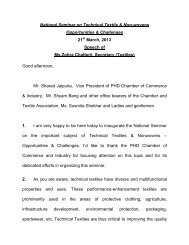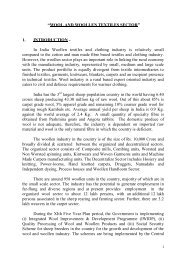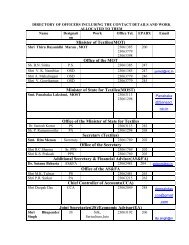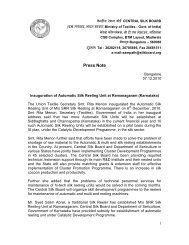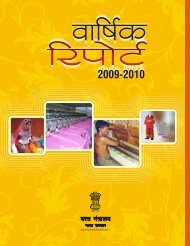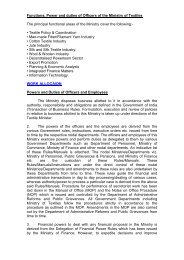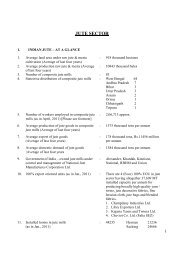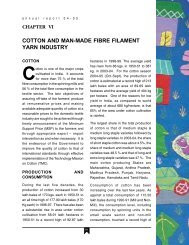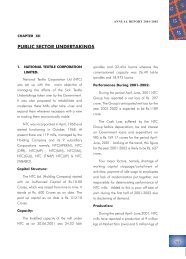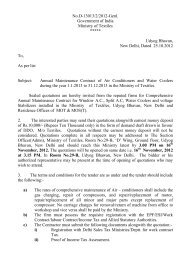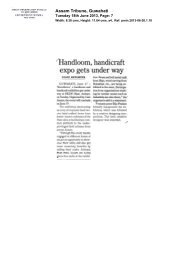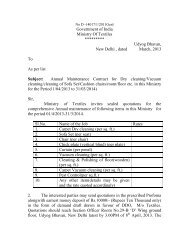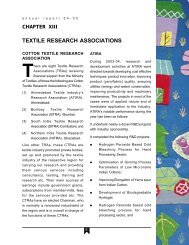- Page 1 and 2: www.ministryoftextiles.gov.in
- Page 4: CONTENTSSl.No. Chapter PageI Highli
- Page 7: 2ministry of textiles
- Page 11 and 12: ministry of textilesor entire texti
- Page 13 and 14: ministry of textilesGroups A, B, C
- Page 15 and 16: ministry of textilescultivation, th
- Page 17 and 18: ministry of textilesregistered an i
- Page 19 and 20: ministry of textilesupgradation, aw
- Page 21 and 22: ministry of textiles●Providing In
- Page 23 and 24: ministry of textilesHindi Fortnight
- Page 25 and 26: 20ministry of textiles
- Page 27 and 28: ministry of textiles●●●●●
- Page 29 and 30: ministry of textilesand Jute Textil
- Page 31 and 32: ministry of textilesinto force the
- Page 33 and 34: ministry of textilesTable 2.2LIST O
- Page 35 and 36: 30ministry of textiles
- Page 37 and 38: ministry of textilesTable 3.1(In Mn
- Page 39 and 40: ministry of textilesThe employment
- Page 41 and 42: ministry of textilesii)iii)iv)The e
- Page 43 and 44: ministry of textilesEligibilityAny
- Page 45 and 46: ministry of textiles(iv)processing
- Page 47 and 48: ministry of textilesa financial cap
- Page 49 and 50: 44ministry of textiles
- Page 51 and 52: ministry of textilesTable 4.1India'
- Page 53 and 54: ministry of textiles●Considerable
- Page 55 and 56: ministry of textilesExport Promotio
- Page 57 and 58: ministry of textilesexcellence in t
- Page 59 and 60:
ministry of textilesForeign Student
- Page 61 and 62:
ministry of textilesresearch output
- Page 63 and 64:
ministry of textiles●●In associ
- Page 65 and 66:
ministry of textilesA view of Appar
- Page 67 and 68:
ministry of textilesSalient Feature
- Page 69 and 70:
64ministry of textiles
- Page 71 and 72:
66ministry of textiles
- Page 73 and 74:
ministry of textilesMaharashtra, Ma
- Page 75 and 76:
ministry of textilesTable 5.2IMPORT
- Page 77 and 78:
ministry of textilesintergovernment
- Page 79 and 80:
74ministry of textiles
- Page 81 and 82:
76ministry of textiles
- Page 83 and 84:
ministry of textilesincreased by 28
- Page 85 and 86:
ministry of textilesjute including
- Page 87 and 88:
ministry of textilesProduction in a
- Page 89 and 90:
ministry of textilesMT valued at Rs
- Page 91 and 92:
ministry of textilesTable 6.10Quant
- Page 93 and 94:
ministry of textilesTable 6.12(Rs i
- Page 95 and 96:
ministry of textilesTable 6.14Sl. M
- Page 97 and 98:
ministry of textilesTable 6.19Schem
- Page 99 and 100:
ministry of textilesThe Objectives
- Page 101 and 102:
ministry of textiles● Skill Devel
- Page 103 and 104:
98ministry of textiles
- Page 105 and 106:
ministry of textilessponsored and c
- Page 107 and 108:
ministry of textiles●IT INITIATIV
- Page 109 and 110:
ministry of textilesProject Approac
- Page 111 and 112:
ministry of textilesGhana, Cambodia
- Page 113 and 114:
ministry of textilesIII(g)SPECIAL S
- Page 115 and 116:
ministry of textilesdominated Kathi
- Page 117 and 118:
ministry of textilesVI.UPGRADATION
- Page 119 and 120:
ministry of textiles●twisting dev
- Page 121 and 122:
116ministry of textiles
- Page 123 and 124:
118ministry of textiles
- Page 125 and 126:
ministry of textilesscheme in all m
- Page 127 and 128:
ministry of textileswoollens. Under
- Page 129 and 130:
124ministry of textiles
- Page 131 and 132:
126ministry of textiles
- Page 133 and 134:
ministry of textilesTable 9.2Year T
- Page 135 and 136:
ministry of textilesThe scheme aims
- Page 137 and 138:
ministry of textileswas first const
- Page 139 and 140:
134ministry of textiles
- Page 141 and 142:
ministry of textilesTable 10.1Cloth
- Page 143 and 144:
ministry of textilesTable 10.3Zone-
- Page 145 and 146:
ministry of textilesThe new benefic
- Page 147 and 148:
ministry of textiles●●●●und
- Page 149 and 150:
ministry of textilesincurred by IIH
- Page 151 and 152:
ministry of textilessector at compe
- Page 153 and 154:
ministry of textilesTable 10.16Exhi
- Page 155 and 156:
ministry of textilesTable 10.17Item
- Page 157 and 158:
ministry of textiles14 Heimtextil I
- Page 159 and 160:
154ministry of textiles
- Page 161 and 162:
ministry of textilesconstraints, se
- Page 163 and 164:
ministry of textilesVI.Setting up o
- Page 165 and 166:
ministry of textilesalso any three
- Page 167 and 168:
ministry of textiles● Asia's Fash
- Page 169 and 170:
ministry of textilesPublicity of In
- Page 171 and 172:
ministry of textiles●Organized pa
- Page 173 and 174:
ministry of textiles●Industry-dri
- Page 175 and 176:
ministry of textilesLacquering, Pow
- Page 177 and 178:
ministry of textiles●●●●●
- Page 179 and 180:
ministry of textilesIIISetting up o
- Page 181 and 182:
176ministry of textiles
- Page 183 and 184:
ministry of textilesrehabilitation
- Page 185 and 186:
ministry of textilesTable 12.1(Rs.
- Page 187 and 188:
ministry of textilesSalary & wage s
- Page 189 and 190:
ministry of textilesTable 12.7Schem
- Page 191 and 192:
ministry of textilesA Cabinet note
- Page 193 and 194:
ministry of textilesprofit of Rs.17
- Page 195 and 196:
ministry of textilesCAPITALThe Auth
- Page 197 and 198:
ministry of textilesfamilies of Jut
- Page 199 and 200:
ministry of textilesRestart of Jute
- Page 201 and 202:
ministry of textilesRevision in the
- Page 203 and 204:
ministry of textileswith a total Co
- Page 205 and 206:
ministry of textilesagencies and to
- Page 207 and 208:
202ministry of textiles
- Page 209 and 210:
204ministry of textiles
- Page 211 and 212:
ministry of textiles3. Shuttleless
- Page 213 and 214:
ministry of textilesElectricity Boa
- Page 215 and 216:
ministry of textilesTable 13.8S. Pr
- Page 217 and 218:
ministry of textiles31.12.10, major
- Page 219 and 220:
ministry of textilesumbrella winche
- Page 221 and 222:
ministry of textileshas conducted c
- Page 223 and 224:
ministry of textilesAgrotextiles, s
- Page 225 and 226:
ministry of textilesdemand upon the
- Page 227 and 228:
ministry of textilesapplications in
- Page 229 and 230:
ministry of textilesAchievementThe
- Page 231 and 232:
ministry of textilessystem using wo
- Page 233 and 234:
ministry of textiles(b)assessment o
- Page 235 and 236:
ministry of textilesThe total reven
- Page 237 and 238:
ministry of textilesnetwork of part
- Page 239 and 240:
ministry of textilesGI Facilitation
- Page 241 and 242:
ministry of textilesGrant in-Aid fo
- Page 243 and 244:
ministry of textilesTable 13.19Sl.
- Page 245 and 246:
240ministry of textiles
- Page 247 and 248:
ministry of textilesTable 14.1S. Ma
- Page 249 and 250:
ministry of textilesSr. Offices Pub
- Page 251 and 252:
ministry of textilesSr. Name Addres
- Page 253 and 254:
248ministry of textiles
- Page 255 and 256:
250ministry of textiles
- Page 257 and 258:
ministry of textilesschemes / compo
- Page 259 and 260:
254ministry of textiles
- Page 261 and 262:
ministry of textilesDuring 2010-11,
- Page 263 and 264:
ministry of textilesSERICULTURE SEC
- Page 265 and 266:
260ministry of textiles
- Page 267 and 268:
ministry of textilessponsored Catal
- Page 269 and 270:
264ministry of textiles
- Page 271 and 272:
ministry of textilesApart from this
- Page 273 and 274:
268ministry of textiles
- Page 275 and 276:
270ministry of textiles
- Page 277 and 278:
ministry of textilesheld on issues
- Page 279 and 280:
274ministry of textiles
- Page 281 and 282:
ministry of textiles(Handicrafts) r
- Page 283 and 284:
ministry of textilesTable 20.1COMME
- Page 285 and 286:
ministry of textilesCIVILS. Report
- Page 287 and 288:
282ministry of textiles
- Page 289 and 290:
ministry of textilesS. Office/Organ


